Watermelon Begonia, also known as Peperomia argyreia, is a charming and unique houseplant that has captured the hearts of plant enthusiasts worldwide. Its common name is derived from the striking resemblance its leaves bear to the rind of a watermelon. This popular ornamental plant is a native of South America, particularly the rainforests of Peru and northern regions of Brazil.
Key Features of Watermelon Begonia:
- Leaf Pattern: The most distinctive feature of Watermelon Begonia is its leaves, which are round and fleshy, resembling watermelon rinds. These leaves are adorned with silvery-green stripes that resemble the markings on a watermelon, making them visually appealing.
- Size: Watermelon Begonia is a relatively compact plant, typically growing to a height of 6 to 8 inches and a width of 12 to 18 inches.
- Flowering: While Watermelon Begonia is primarily grown for its stunning foliage, it can produce small, inconspicuous flowers on upright spikes. These flowers are usually cream or green in color.
- Low Maintenance: This plant is known for being low-maintenance, making it an excellent choice for both beginners and experienced plant enthusiasts.



Genus Species
The Watermelon Begonia belongs to the Peperomia genus, a diverse group of plants known for their unique foliage and ease of care. The botanical name for this charming plant is “Peperomia argyreia.” Understanding the genus and species of a plant is essential for providing the right care.
Peperomia Genus:
Peperomia is a vast genus comprising more than 1,000 species of small, easy-to-care-for plants, primarily hailing from tropical and subtropical regions in Central and South America. These plants are known for their varied leaf shapes and patterns, which contribute to their appeal as houseplants.
Peperomia argyreia (Watermelon Begonia):
Peperomia argyreia is a specific species within the Peperomia genus. Its common name, Watermelon Begonia, is attributed to the appearance of its leaves. As mentioned earlier, its lush, watermelon-like foliage is its defining characteristic.
Similar Varieties:
While Watermelon Begonia is a unique and striking species, there are other Peperomia varieties that share the same genus and family traits. Some of the more popular ones include Peperomia obtusifolia, Peperomia caperata, and Peperomia prostrata, each with its distinct leaf shapes and patterns.
Understanding the genus and species of your Watermelon Begonia helps you tailor your care routine to its specific requirements, ensuring it thrives in your home.
Watermelon Begonia Appearance
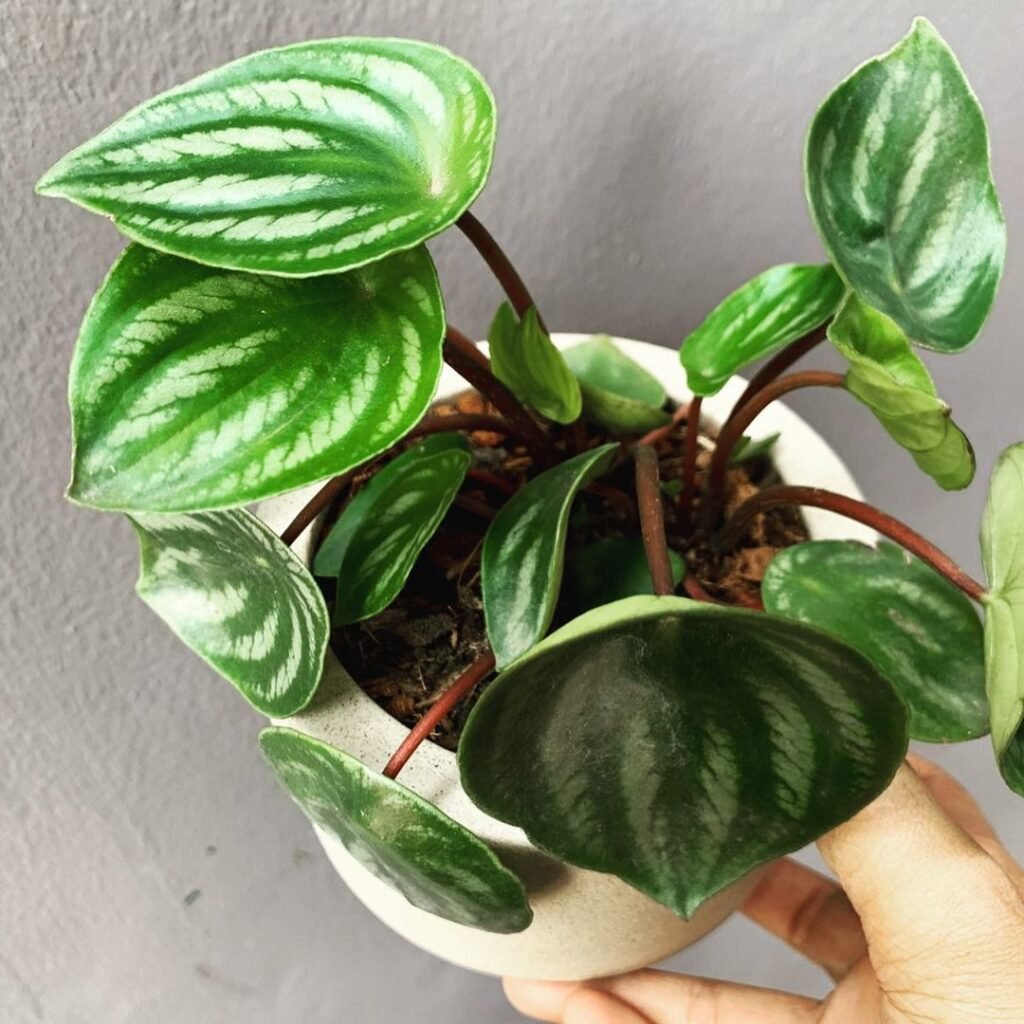

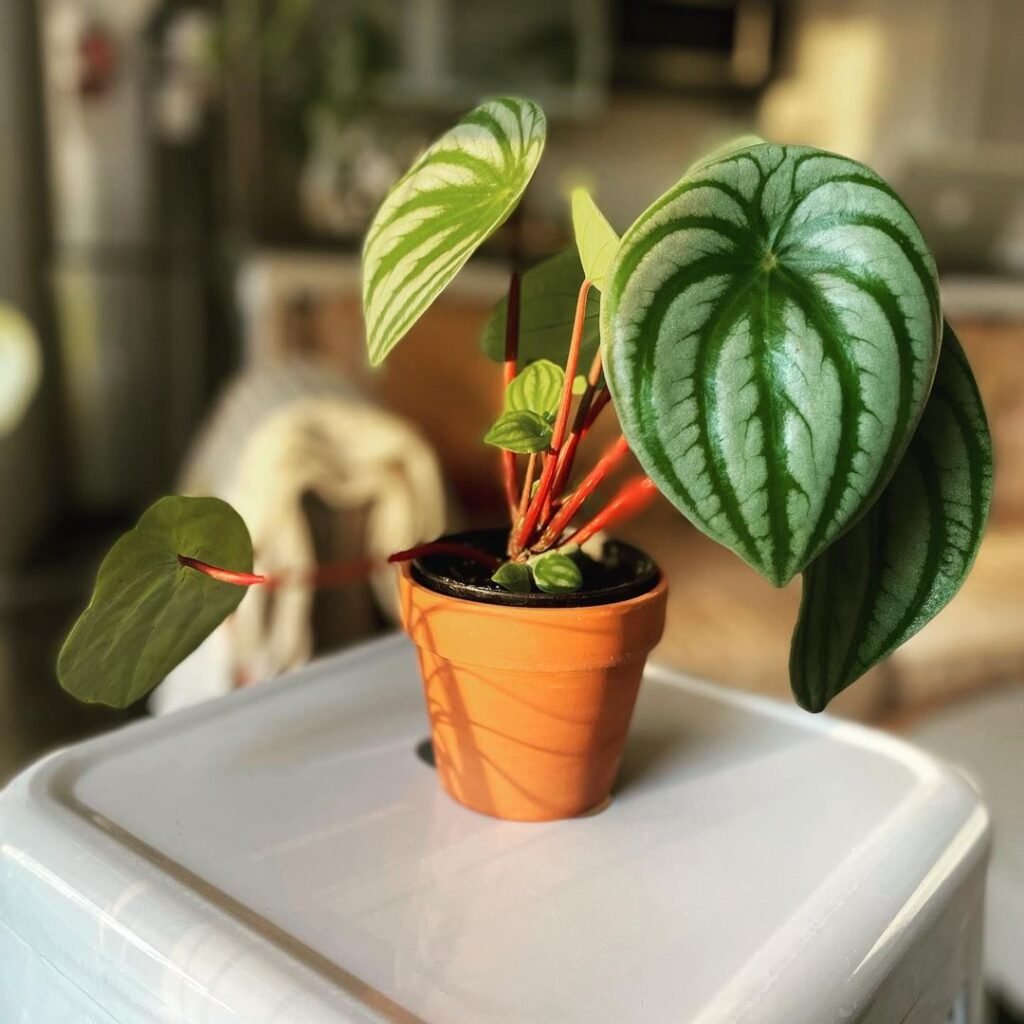
The appearance of the Watermelon Begonia is undoubtedly its standout feature. Let’s delve into more details about its unique visual characteristics and how they make this plant a favorite among indoor gardeners.
Leaves That Resemble Watermelon:
The most captivating feature of Watermelon Begonia is its leaves. These leaves are round, thick, and succulent, giving them a plump appearance. They are covered in silvery-green stripes that closely mimic the markings on a watermelon’s rind. The overall effect is visually stunning, making this plant an excellent addition to your indoor garden.
Compact Growth:
Watermelon Begonia is a compact plant, which means it doesn’t take up much space. It typically grows to a height of 6 to 8 inches and has a spread of 12 to 18 inches. This compact size makes it ideal for small spaces, tabletops, or as part of a group display.
Varied Leaf Patterns:
While the standard Watermelon Begonia exhibits the iconic watermelon-like leaf pattern, there are also variegated varieties with different stripe patterns and colors. Some may have wider or narrower stripes, adding to the diversity of options for plant enthusiasts.
Inconspicuous Flowers:
Watermelon Begonia may produce small, green or cream-colored flowers on upright spikes, but they are usually less prominent compared to its eye-catching foliage. Most growers appreciate this plant primarily for its striking leaves.
The unique appearance of Watermelon Begonia is a testament to its beauty and charm. With its vibrant foliage and easy maintenance, it’s a must-have addition to any indoor garden.
Not the plant for you? Check out my full list of 78 Types of Begonia!
Watermelon Begonia Care Tips
Watermelon Begonia, also known as Peperomia argyreia, is a delightful houseplant with striking watermelon-like leaves. Proper care is essential to ensure its health and maintain its distinctive appearance. Here’s an overview of key care tips for your Watermelon Begonia:
| Care Aspect | Tips and Tricks |
|---|---|
| Light Requirements | – Provide bright, indirect light. Avoid direct sun, as it can scorch the leaves. If possible, place near an east or north-facing window. Fluorescent lights work well for indoor cultivation. |
| Soil | – Use a well-draining potting mix. A mixture of peat moss and perlite is suitable. Ensure the pot has drainage holes to prevent overwatering. |
| Watering | – Allow the top inch of soil to dry out between waterings. Water thoroughly, but do not let the plant sit in standing water. Watering frequency may vary with the seasons. |
| Humidity & Temperature | – Watermelon Begonia thrives in high humidity. Mist the leaves regularly or use a humidity tray. Keep the temperature between 65-75°F (18-24°C) and protect it from drafts. |
| Fertilizing | – Use a balanced, water-soluble fertilizer during the growing season (spring and summer) every 4-6 weeks. Reduce or halt feeding in the winter months. |
| Pruning & Shaping | – Prune leggy or overgrown stems to encourage bushier growth. Pinch off the tips to maintain its compact shape. Remove any yellow or damaged leaves. |
Following these care tips will help your Watermelon Begonia thrive and maintain its captivating appearance.

Watermelon Begonia Light and Soil Requirements
Understanding the light and soil requirements of your Watermelon Begonia is crucial for its well-being. Let’s explore these aspects in detail:
Light Requirements:
Watermelon Begonia thrives in bright, indirect light. It’s essential to strike the right balance, as too much direct sunlight can scorch its leaves. Here’s how to ensure your plant gets the ideal lighting conditions:
- Ideal Location: Place your Watermelon Begonia near an east or north-facing window where it can receive bright, indirect sunlight. If your home lacks adequate natural light, consider using fluorescent lights to provide the necessary illumination.
- Rotation: To ensure even growth and prevent the plant from leaning towards the light source, periodically rotate your Watermelon Begonia by a quarter-turn.
Soil Requirements:
Proper soil is the foundation of a healthy Watermelon Begonia. The key is to use a well-draining potting mix that prevents overwatering. Here are the details:
- Potting Mix: Opt for a well-draining mix, which typically includes components like peat moss and perlite. This mix prevents water from accumulating around the roots.
- Drainage: Ensure that the pot or container has drainage holes. These holes are crucial in preventing waterlogged soil, which can lead to root rot.
- Repotting: As your Watermelon Begonia grows, consider repotting it every 2-3 years to provide fresh soil and more room for its roots.
Maintaining the right light and soil conditions is vital to the overall health and appearance of your Watermelon Begonia.
Watering Watermelon Begonia
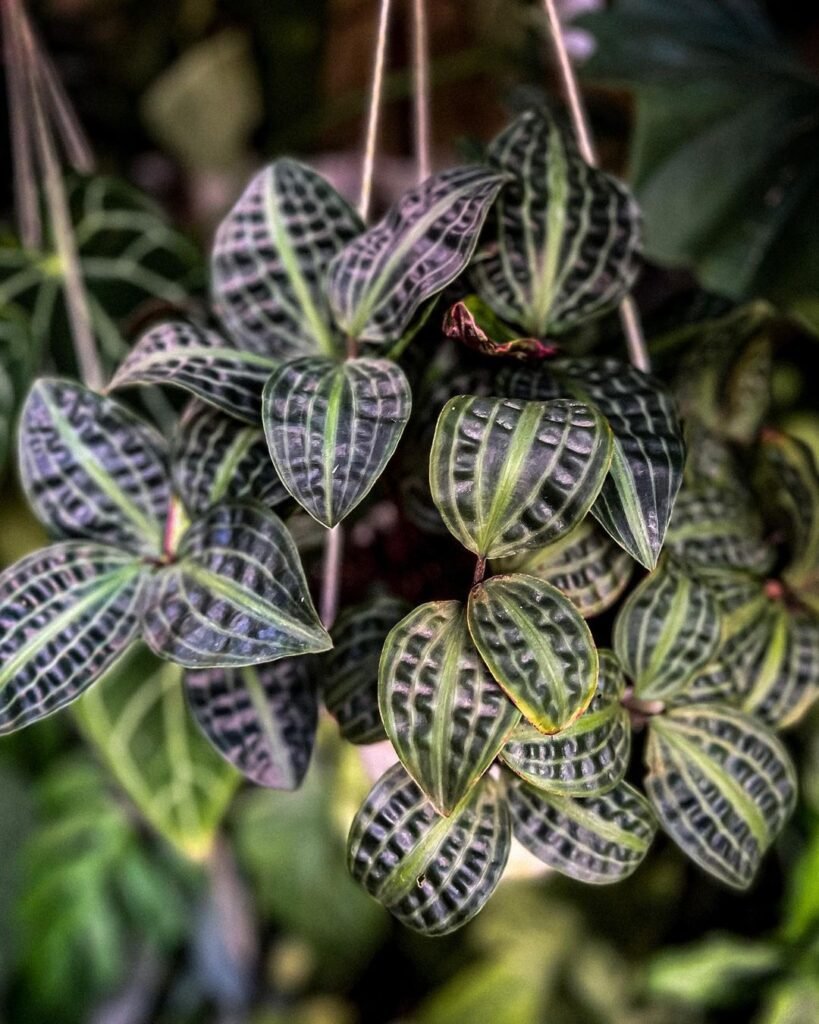

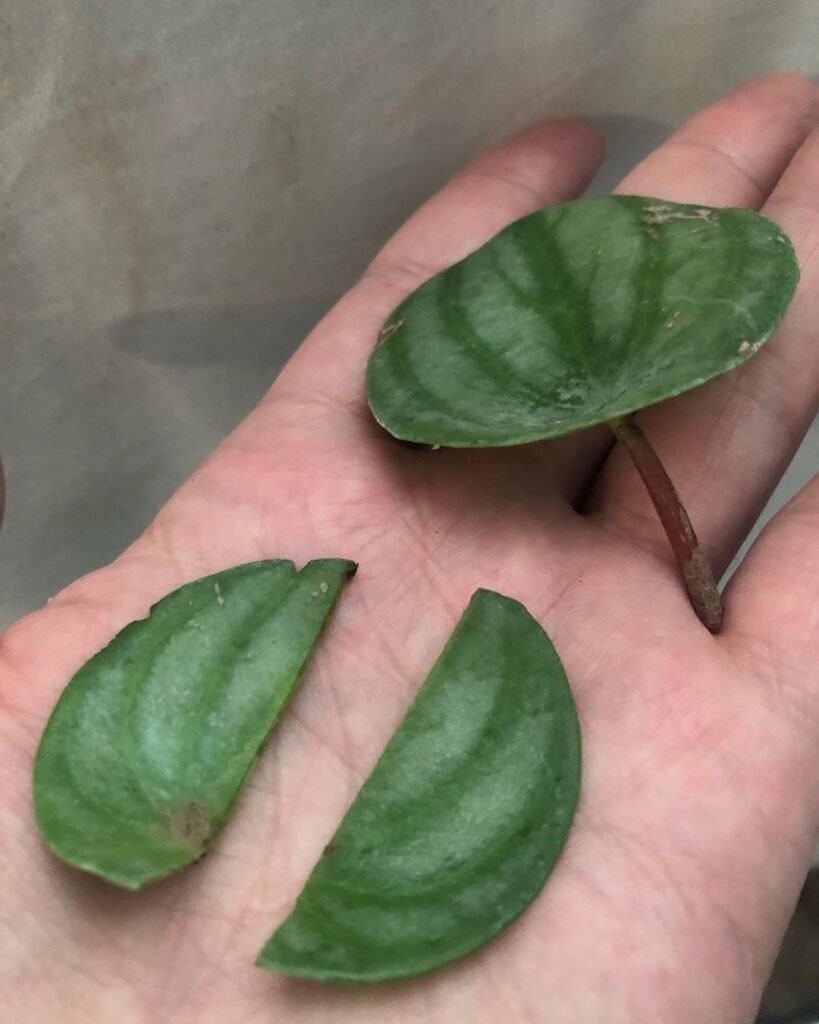
Watering your Watermelon Begonia is a critical aspect of its care. Proper watering ensures the plant remains healthy and its leaves vibrant. Let’s dive into the details of watering this delightful houseplant:
- Allow Drying: Watermelon Begonia prefers to dry out slightly between waterings. To gauge when it’s time to water, stick your finger into the soil up to an inch deep. If it feels dry, it’s time to water.
- Watering Technique: When it’s time to water, do so thoroughly but avoid overwatering. Water the plant until you see water seeping out of the drainage holes at the bottom of the pot. This ensures that the entire root system gets hydrated.
- Water Quality: Use room-temperature, filtered water whenever possible. Avoid using water with a high mineral content, as it can lead to leaf spotting.
- Seasonal Adjustments: Adjust your watering frequency based on the season. Watermelon Begonia may need more frequent watering during the active growing season (spring and summer) and less during the dormant winter months.
By paying attention to your Watermelon Begonia’s watering needs, you’ll help it thrive and maintain its captivating appearance.
Watermelon Begonia Humidity and Temperature
Maintaining the right levels of humidity and temperature is crucial for the well-being of your Watermelon Begonia. Let’s explore these aspects in detail:
Humidity:
Watermelon Begonia is native to tropical regions and thrives in high humidity. To create a suitable environment for your plant:
- Misting: Regularly mist the leaves with room-temperature water to increase humidity levels. This is particularly important in dry indoor environments.
- Humidity Tray: Place a humidity tray filled with water and pebbles near your plant. As the water evaporates, it raises the humidity around the plant.
- Grouping Plants: Grouping your Watermelon Begonia with other houseplants can create a microclimate with higher humidity.
Temperature:
Maintaining the right temperature range is equally important:
- Ideal Range: Keep your Watermelon Begonia in a temperature range of 65-75°F (18-24°C). Avoid exposure to drafts or sudden temperature fluctuations.
- Winter Care: In the winter months, if your indoor air becomes dry due to heating, consider using a humidifier to maintain adequate moisture levels.
By ensuring the right balance of humidity and temperature, you’ll create the perfect environment for your Watermelon Begonia to thrive.
Fertilizing Watermelon Begonia

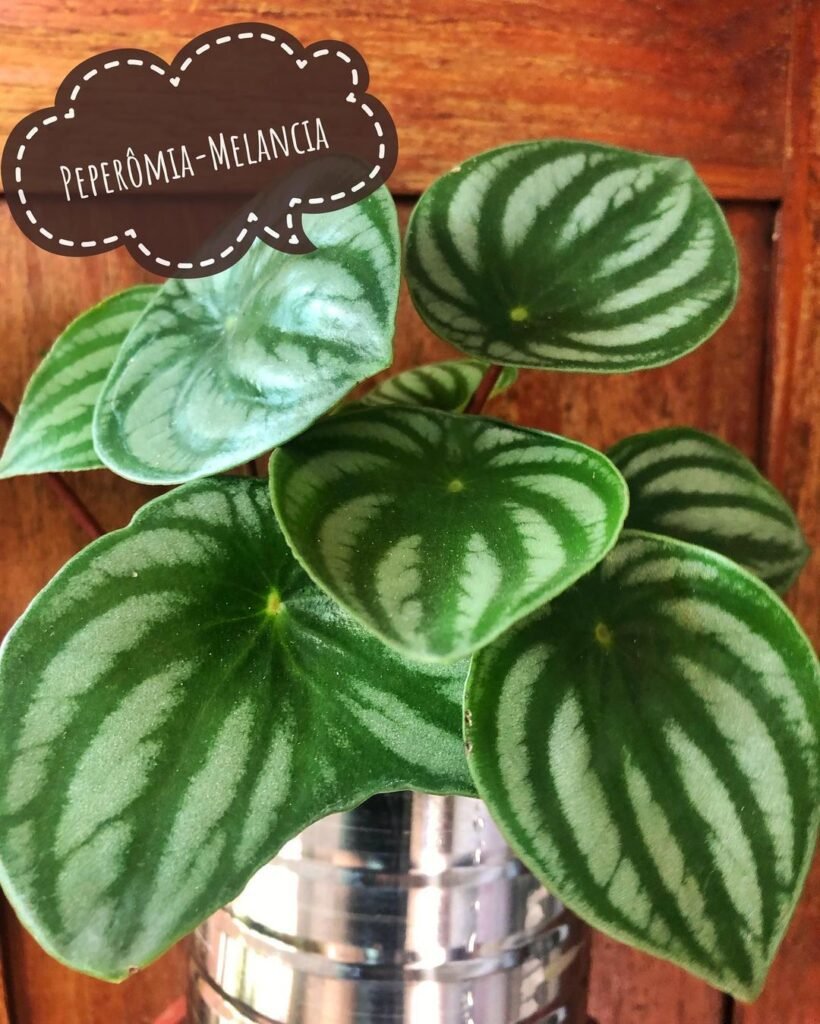
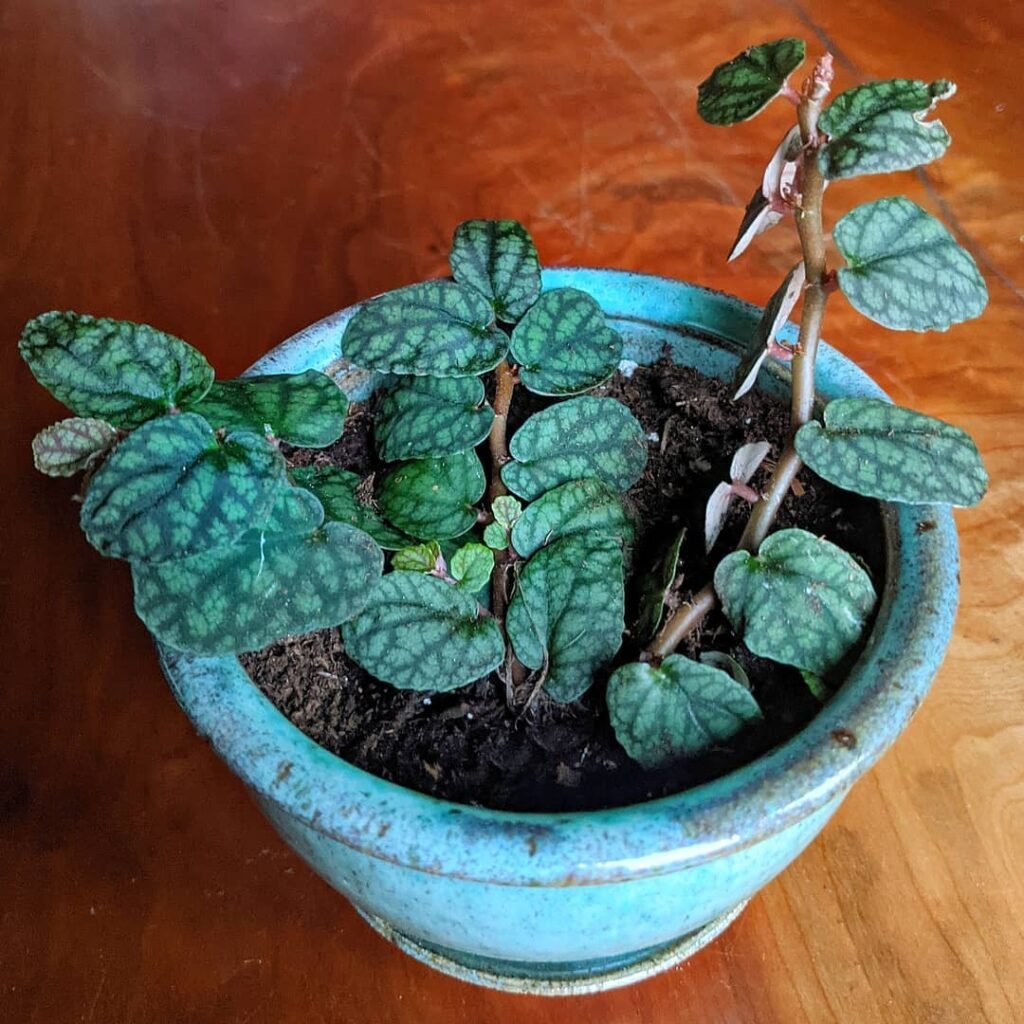
Proper fertilization is essential to ensure your Watermelon Begonia receives the necessary nutrients for healthy growth and vibrant foliage. Here’s how to fertilize your plant effectively:
- Fertilizer Type: Use a balanced, water-soluble fertilizer with a ratio like 20-20-20 or 10-10-10. These balanced fertilizers provide essential nutrients without overstimulating one aspect of growth at the expense of another.
- Fertilizing Schedule: During the active growing season, which typically includes spring and summer, feed your Watermelon Begonia every 4-6 weeks. Dilute the fertilizer to half the recommended strength to prevent over-fertilization.
- Winter Feeding: Reduce or completely halt fertilization during the dormant winter months. At this time, the plant’s growth slows, and it requires fewer nutrients.
- Application Method: Apply the diluted fertilizer to moist soil. Avoid direct contact with the leaves to prevent burning. Water the plant thoroughly after fertilizing.
- Flush the Soil: Every 2-3 months, it’s a good practice to flush the soil by thoroughly watering the plant until water runs out of the drainage holes. This helps prevent the buildup of excess salts from the fertilizer.
Proper and timely fertilization will ensure that your Watermelon Begonia remains healthy and its leaves maintain their striking appearance.
Watermelon Begonia Pruning and Shaping

Pruning and shaping your Watermelon Begonia is essential to encourage bushier growth and maintain its attractive form. Here’s how to go about it:
- Pruning Leggy Stems: If you notice leggy or elongated stems, prune them back to encourage a more compact and bushy appearance. Use clean, sharp scissors or pruning shears.
- Tip Pinching: Regularly pinch off the growing tips of your Watermelon Begonia to promote branching. This will help create a denser, more attractive plant.
- Remove Yellow or Damaged Leaves: As part of routine maintenance, remove any yellow or damaged leaves to maintain the plant’s aesthetic appeal and overall health.
- Shape Maintenance: Periodically assess the overall shape of your Watermelon Begonia and trim or shape it as needed to achieve the desired look.
Pruning and shaping should be done with care to avoid damaging the plant. Regular maintenance will help your Watermelon Begonia stay healthy and aesthetically pleasing.
Watermelon Begonia Propagation and Repotting
Propagation and repotting are essential aspects of Watermelon Begonia care. These actions help maintain the health and vigor of your plant and allow you to expand your collection. Here’s what you need to know:
Propagation:
Watermelon Begonia can be propagated through stem cuttings. Follow these steps to successfully propagate your plant:
- Select Healthy Cuttings: Choose a healthy stem with several leaves. Cut a section of the stem that is approximately 3-4 inches long. Ensure that it has at least one node (the small bump where leaves and roots emerge).
- Remove Lower Leaves: Trim off the lower leaves, leaving only a couple of leaves at the top. This will encourage root development and reduce water loss.
- Rooting Medium: Plant the cutting in a well-draining rooting medium, such as a mix of perlite and peat moss. Water lightly to settle the medium around the cutting.
- Provide Indirect Light: Place the cutting in a location with bright, indirect light. Cover it with a clear plastic bag or a plastic dome to create a mini greenhouse effect, which helps maintain high humidity.
- Root Development: After a few weeks, the cutting should develop roots. Once the roots are well-established, you can transplant it into a small pot with regular potting soil.
Repotting:
Repotting is necessary when your Watermelon Begonia outgrows its current container or when the soil becomes depleted. Here are the key steps for successful repotting:
- Choose the Right Time: The best time to repot your Watermelon Begonia is in the spring when it’s actively growing. Repotting during this period minimizes stress on the plant.
- Select a Slightly Larger Pot: Choose a new pot that is only slightly larger than the current one. A pot that’s 1-2 inches larger in diameter is usually sufficient.
- Gently Remove the Plant: Carefully remove the plant from its current pot, taking care not to damage the roots.
- Refresh the Soil: Prepare fresh, well-draining potting mix. Place a layer of this mix in the new pot.
- Reposition the Plant: Position the Watermelon Begonia in the new pot, ensuring it’s at the same depth as it was in the previous container.
- Fill with Soil: Fill the remaining space in the pot with the fresh potting mix, gently pressing it down to eliminate air pockets.
- Water Thoroughly: Water the plant thoroughly after repotting to help settle the soil.
- Monitor and Care: Keep an eye on your repotted Watermelon Begonia and ensure it adjusts well to its new container.
Propagation and repotting are essential practices that will help you maintain a healthy and vibrant Watermelon Begonia.
Watermelon Begonia Seasonal Care
Adapting your care routine to the changing seasons is crucial for the well-being of your Watermelon Begonia. Let’s explore how to care for your plant throughout the year:
Spring and Summer:
- Light: During the active growing season, maintain bright, indirect light. Ensure the plant receives at least a few hours of indirect sunlight each day.
- Watering: Water more frequently as the plant’s growth increases. Allow the top inch of soil to dry between waterings.
- Fertilizing: Feed your Watermelon Begonia every 4-6 weeks with a balanced, water-soluble fertilizer.
- Pruning: Trim leggy stems and pinch off growing tips to encourage bushier growth.
Fall:
- Light: As the days shorten, reduce the amount of direct sunlight the plant receives. Maintain bright, indirect light.
- Watering: Reduce the frequency of watering as the plant’s growth slows down. Let the soil dry out a bit more between waterings.
- Fertilizing: Gradually reduce or halt fertilization as the plant enters its dormant period.
- Temperature: Ensure your Watermelon Begonia is not exposed to cold drafts as the weather cools.
Winter:
- Light: Provide bright, indirect light and consider using supplemental grow lights if natural light is limited.
- Watering: Water sparingly during the winter. The plant’s growth is minimal, so it requires less moisture.
- Humidity: Ensure humidity levels are maintained, as indoor heating can dry the air.
By adjusting your care routine to the changing seasons, you’ll provide the best conditions for your Watermelon Begonia’s health and appearance.
Watermelon Begonia Companion Plants
Pairing your Watermelon Begonia with suitable companion plants can create a visually appealing indoor garden. Here are some great choices to complement your Watermelon Begonia:
| Companion Plant | Characteristics |
|---|---|
| Pothos (Epipremnum aureum) | – Pothos is known for its easy care and attractive, trailing vines. It complements the Watermelon Begonia’s lush foliage. |
| Spider Plant (Chlorophytum comosum) | – Spider plants are hardy, air-purifying houseplants that thrive in similar light and humidity conditions. They provide a nice contrast in texture. |
| Peace Lily (Spathiphyllum) | – Peace lilies are elegant, low-maintenance plants that add a touch of elegance to your indoor garden. They also thrive in medium to low light conditions. |
When selecting companion plants, consider the lighting and humidity requirements to ensure they are compatible with your Watermelon Begonia. The right combination can enhance the overall aesthetic of your indoor garden.
Pest Control Tips for Watermelon Begonia
Maintaining a pest-free environment is essential for the health of your Watermelon Begonia. Here are some common pests to watch out for and effective control measures:
| Common Pests | Control Measures |
|---|---|
| Mealybugs | – Use a cotton swab soaked in rubbing alcohol to gently remove mealybugs. – Treat with neem oil or insecticidal soap for severe infestations. |
| Spider Mites | – Increase humidity to deter spider mites. – Spray the plant with a mix of water and a few drops of dish soap. |
| Aphids | – Spray the plant with a strong stream of water to dislodge aphids. – Use neem oil or insecticidal soap as a treatment. |
| Fungus Gnats | – Allow the soil to dry out more between waterings to reduce the fungus gnat population. – Use yellow sticky traps to catch adult gnats. |
| Scale Insects | – Use a soft brush or cloth to gently remove scale insects. – Apply neem oil to control infestations. |
| Thrips | – Isolate the infected plant to prevent thrips from spreading. – Apply insecticidal soap to affected areas. |
Regularly inspect your Watermelon Begonia for signs of pests and take prompt action to prevent infestations from spreading.
Reviving a Sick or Wilting Watermelon Begonia
If your Watermelon Begonia appears to be wilting or unhealthy, it’s crucial to take action to revive it. Here are steps to help nurse your plant back to health:
- Check Watering: Assess the soil’s moisture level. If the soil is too dry or waterlogged, adjust your watering routine. Water thoroughly but allow the top inch to dry between waterings.
- Light: Ensure the plant is getting the right amount of light. If it’s receiving too much direct sun, move it to a location with indirect light.
- Pruning: Trim any yellow or damaged leaves and prune leggy stems to encourage bushier growth.
- Repotting: If the roots are overcrowded or the soil has become depleted, consider repotting your Watermelon Begonia into fresh, well-draining soil.
- Pest Control: Examine your plant for signs of pests, as they can cause wilting. If you identify pests, follow the appropriate pest control measures.
- Humidity: Ensure that your plant is in a high-humidity environment. Use a humidity tray, mist the leaves, or consider a small room humidifier.
- Fertilization: Review your fertilization schedule. If you’ve been overfeeding, reduce or halt fertilization until the plant recovers.
By addressing these issues and providing the necessary care, you can often revive a sick or wilting Watermelon Begonia.
Love all types of Begonia? Make sure to catch up on my post on how to care and grow for begonia pavonina. After you’ve finished reading that, why not also check out my care guide on how to grow iron cross begonia.
Conclusion
In conclusion, Watermelon Begonia, scientifically known as Peperomia argyreia, is a captivating houseplant admired for its unique watermelon-like leaves. With the right care, including proper lighting, soil, watering, and seasonal adjustments, you can maintain its health and striking appearance. Regular pruning and shaping are essential to encourage bushier growth.
When considering companion plants, options like Pothos, Spider Plant, and Peace Lily can complement your Watermelon Begonia, creating an aesthetically pleasing indoor garden.
Remember to be vigilant against common pests, such as mealybugs, spider mites, aphids, scale insects, and fungus gnats. Prompt pest control measures can help protect your plant.
If your Watermelon Begonia appears sick or wilting, follow the steps provided to nurse it back to health, ensuring it remains a vibrant and attractive addition to your indoor garden.
FAQs
Is the Watermelon Begonia safe for pets?
Yes, Watermelon Begonia is generally considered non-toxic to pets. However, it’s always a good practice to keep any houseplants out of reach of curious pets to avoid accidental ingestion.
How often should I fertilize my Watermelon Begonia?
During the growing season (spring and summer), it’s best to fertilize your Watermelon Begonia every 4-6 weeks. Reduce or halt fertilization during the dormant winter months.
Can I place my Watermelon Begonia outdoors?
While Watermelon Begonia is primarily an indoor plant, it can benefit from spending time outdoors during the warm summer months. Ensure it is placed in a shaded or filtered light area to avoid direct sun exposure, which can harm the leaves.
Why are the leaves on my Watermelon Begonia turning yellow?
Yellow leaves on a Watermelon Begonia can be due to various reasons, including overwatering, underwatering, pest infestations, or inadequate light. Identifying the specific cause and addressing it is essential to restore the plant’s health.

Writer/Green Thumb/Explorer – Rooted deep in the rich soils of Devon, I’ve cultivated a vast expertise in plant care, helping greenery thrive in homes across the UK. When I’m not crafting detailed plant care guides, I’m journeying through the lush landscapes of the West Country, unearthing nature’s secrets and sharing them with fellow plant enthusiasts. Every leaf has a story, and I’m here to tell it.





